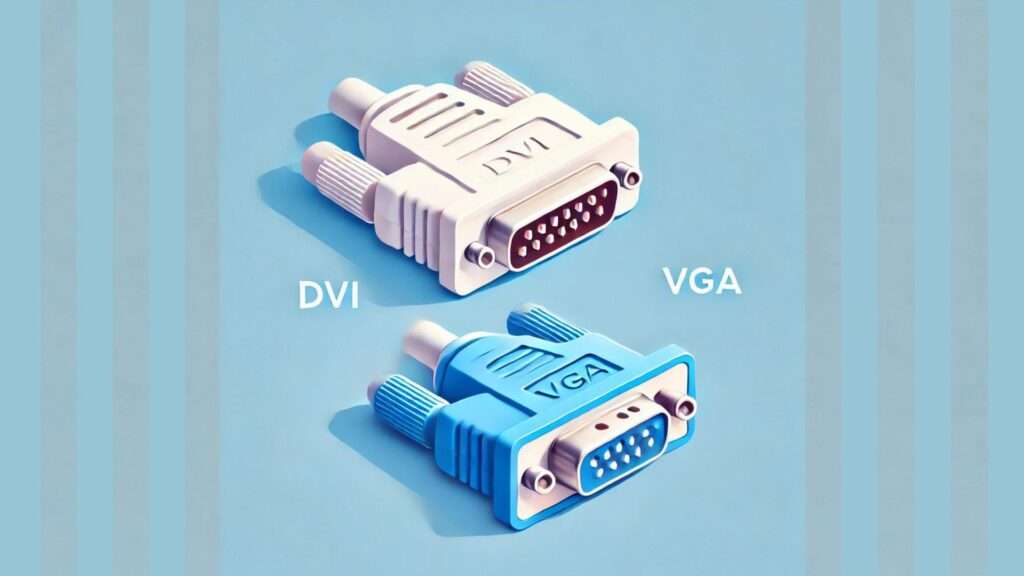
DVI vs VGA, choosing between them can be challenging for those unsure about which option suits their needs best. DVI stands for Digital Visual Interface, offering superior image quality compared to VGA, which is an analog standard known as Video Graphics Array. The main differences lie in signal type, resolution, and compatibility.
VGA’s analog connection often results in lower image quality, especially with longer cables. In contrast, DVI provides a clearer, sharper display. The complete guide on the differences between DVI and VGA, covering signal type, resolution, connectors, applications, and future-proofing, is given in this article.
What is a DVI?
A DVI (Digital Visual Interface) is a video display interface developed to provide a high-quality visual connection between a computer and a monitor. The DVI connector supports digital signals, which allow for sharper and clearer images compared to analog connections. DVI cables come in three main types: DVI-D (digital only), DVI-A (analog only), and DVI-I (integrated, supporting both digital and analog signals). This versatility makes it compatible with a wide range of devices, from LCD monitors to video cards. The DVI port typically features a set of pins arranged to carry both the video signal and the synchronization data. Adapters are available to convert DVI to other interfaces, such as HDMI and VGA, enhancing its utility in various setups.
What is a VGA?
A VGA (Video Graphics Array) is an older video display standard that transmits analog signals from a computer to a monitor. VGA connectors, recognized by their blue 15-pin configuration, are widely used for connecting video cards to displays. Despite being considered outdated compared to digital interfaces like DVI and HDMI, VGA cables remain prevalent due to their compatibility with many legacy systems. VGA ports are still found on various devices, including projectors and older LCD monitors. The analog signal transmitted through VGA can be prone to interference, leading to lower image quality compared to digital signals. However, adapters are available to connect VGA to DVI or HDMI ports, extending its usability.
DVI vs VGA: Key Differences
1. Signal Type:
DVI and VGA differ primarily in their signal type. VGA, known as Video Graphics Array, transmits an analog signal, which can degrade over longer cable lengths. In contrast, DVI, which stands for Digital Visual Interface, transmits digital signals, maintaining better picture quality over longer distances. The analog connection in VGA may cause signal loss, impacting image clarity. DVI can carry both analog and digital signals, offering versatility. Compared to VGA, DVI provides superior signal quality, making it a preferred choice for modern display devices.
2. Resolution and Image Quality:
VGA’s analog signal supports lower resolutions and can result in reduced image clarity on higher-resolution displays. DVI supports higher resolutions and maintains better clarity and sharpness. DVI is newer and supports both single-link and dual-link formats, offering higher resolutions and better image quality. VGA to DVI adapters can be used to connect older VGA monitors to DVI sources, but the image quality might still be inferior. For high-definition displays, DVI offers a clear advantage in maintaining picture quality without signal degradation.
3. Connector Types and Pins:
VGA connectors are typically blue with 15 pins arranged in three rows. DVI connectors come in various types, including DVI-A, DVI-D, and DVI-I, each with different pin configurations. The standard VGA connector only supports analog signals, while DVI can support both analog and digital signals, depending on the type. DVI connectors and ports are more versatile, allowing for connections with different types of displays. VGA adapters and converters can bridge the gap between VGA and DVI connections, but DVI’s variety of connectors makes it more adaptable for various devices.
4. Applications and Use Cases:
VGA is commonly used in older monitors and projectors that rely on analog signals. DVI, however, is widely used in modern LCD monitors, digital projectors, and other display devices that require high-definition video signals. DVI cards are often used to connect a DVI card to a CRT monitor or an LCD monitor, ensuring compatibility with various display technologies. VGA to DVI and DVI to VGA converters allow older and newer devices to interface, but DVI is preferred for its superior quality in digital applications. HDMI and DVI share similarities, but DVI is more commonly found in PC monitors.
5. Future-Proofing and Availability:
DVI offers better future-proofing compared to VGA, which is becoming less common in newer devices. Standards like HDMI have largely replaced VGA and DVI in modern consumer electronics, but DVI remains relevant in many professional and industrial applications. VGA is an analog standard and is gradually being phased out in favor of digital interfaces like DVI and HDMI. DVI’s ability to carry both analog and digital signals ensures compatibility with a wide range of devices. For longevity and quality, DVI stands out as a more robust option for current and future display needs.
Conclusion
When comparing DVI vs VGA, several distinct differences in signal type, resolution, and compatibility emerge. DVI stands for Digital Visual Interface and supports both analog and digital signals. VGA, or Video Graphics Array, is limited to analog signals, which impacts picture quality and cable length. Standards like HDMI have largely replaced both, but DVI still offers better performance compared to VGA. DVI can support single-link and dual-link formats, enhancing image clarity. Considering these differences between DVI vs VGA, which connection type do you prefer for your display needs?
FAQs
1. Does DVI support analog signals?
Yes, DVI can carry both analog and digital signals, depending on the type.
2. Which has better cable length support, DVI or VGA?
DVI supports longer cables without significant loss in image quality compared to VGA.
3. Can I connect a VGA monitor to a DVI source?
Yes, you can use a VGA to DVI adapter to connect the devices.
4. What are the types of DVI connectors?
Types include DVI-A (analog), DVI-D (digital), and DVI-I (integrated).
5. Is DVI compatible with HDMI?
Yes, DVI is compatible with HDMI using the correct adapter or cable.



